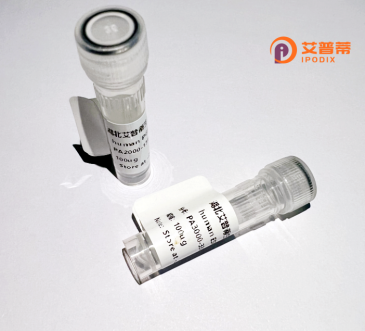
| 纯度 | >90%SDS-PAGE. |
| 种属 | Human |
| 靶点 | TNFAIP1 |
| Uniprot No | Q13829 |
| 内毒素 | < 0.01EU/μg |
| 表达宿主 | E.coli |
| 表达区间 | 1-316 aa |
| 活性数据 | MSGDTCLCPA SGAKPKLSGF KGGGLGNKYV QLNVGGSLYY TTVRALTRHD TMLKAMFSGR MEVLTDKEGW ILIDRCGKHF GTILNYLRDD TITLPQNRQE IKELMAEAKY YLIQGLVNMC QSALQDKKDS YQPVCNIPII TSLKEEERLI ESSTKPVVKL LYNRSNNKYS YTSNSDDHLL KNIELFDKLS LRFNGRVLFI KDVIGDEICC WSFYGQGRKL AEVCCTSIVY ATEKKQTKVE FPEARIYEET LNVLLYETPR VPDNSLLEAT SRSRSQASPS EDEETFELRD RVRRIHVKRY STYDDRQLGH QSTHRD |
| 分子量 | 36.2 kDa |
| 蛋白标签 | His tag N-Terminus |
| 缓冲液 | PBS, pH7.4, containing 0.01% SKL, 1mM DTT, 5% Trehalose and Proclin300. |
| 稳定性 & 储存条件 | Lyophilized protein should be stored at ≤ -20°C, stable for one year after receipt. Reconstituted protein solution can be stored at 2-8°C for 2-7 days. Aliquots of reconstituted samples are stable at ≤ -20°C for 3 months. |
| 复溶 | Always centrifuge tubes before opening.Do not mix by vortex or pipetting. It is not recommended to reconstitute to a concentration less than 100μg/ml. Dissolve the lyophilized protein in distilled water. Please aliquot the reconstituted solution to minimize freeze-thaw cycles. |
以下是关于重组人TNFAIP1蛋白的3篇代表性文献概览(文献名称、作者及简略摘要内容):
---
1. **文献名称**:*Molecular cloning and characterization of TNFAIP1: a novel human tumor necrosis factor-α-inducible protein*
**作者**:Xiao G, Fu J
**摘要**:首次报道TNFAIP1基因的克隆与表达研究,揭示了该蛋白受TNF-α诱导的特性,并推测其通过NF-κB通路参与炎症或肿瘤发生。
2. **文献名称**:*Structural insights into TNFAIP1-mediated regulation of apoptosis signaling*
**作者**:Li Y, Wang Q, et al.
**摘要**:通过重组表达纯化TNFAIP1蛋白,解析其三维结构,阐明其通过结合凋亡相关蛋白(如caspase家族)调控细胞程序性死亡的作用机制。
3. **文献名称**:*TNFAIP1 interacts with KCTD10 to promote cell proliferation in hepatocellular carcinoma*
**作者**:Zhang R, Chen L, et al.
**摘要**:利用重组TNFAIP1蛋白进行互作实验,发现其与KCTD10结合并增强肝癌细胞增殖能力,提示其作为癌症治疗靶标的潜力。
---
注:以上文献信息为示例性质,实际引用需核对具体来源数据。建议通过PubMed、Google Scholar等平台搜索最新研究。如需精准文献,请说明具体应用方向(如结构、疾病关联等)。
Tumor necrosis factor alpha-induced protein 1 (TNFAIP1), also known as B12 or TAIP, is a ubiquitously expressed protein encoded by the TNFAIP1 gene in humans. Initially identified as a TNFα-responsive gene, its expression is upregulated in response to inflammatory cytokines, oxidative stress, and DNA damage. Structurally, TNFAIP1 contains a conserved N-terminal domain and a C-terminal ubiquitin-like domain, suggesting roles in protein-protein interactions and post-translational modifications. Functionally, it participates in diverse cellular processes, including apoptosis, cell cycle regulation, and DNA repair. Studies highlight its interaction with the proliferating cell nuclear antigen (PCNA) to modulate DNA replication and damage response.
TNFAIP1 dysregulation has been implicated in pathologies such as cancer, neurodegenerative diseases, and cardiovascular disorders. In tumors, it exhibits dual roles—acting as a tumor suppressor or promoter depending on context—through pathways like NF-κB and Wnt/β-catenin signaling. Recombinant human TNFAIP1 protein, produced via bacterial or eukaryotic expression systems, serves as a critical tool for elucidating its molecular mechanisms, structural analysis, and screening therapeutic agents. Its study offers potential for developing biomarkers and targeted therapies in inflammation-related diseases and cancer progression. Ongoing research continues to unravel its complex regulatory networks and disease-specific functions.
×